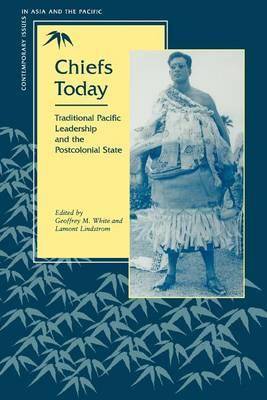Chiefs Today : Traditional Pacific Leadership and the Postcolonial State
- Unit price
- / per
-
Author:WHITE Geoffrey / LINDSTROM Lamont
-
ISBN:9780804728515
-
Publication Date:August 2009
-
Edition:1
-
Pages:368
-
Binding:Paperback
-
Publisher:Stanford University Press
-
Country of Publication:


A Back Order button means that we don’t have the book in stock at our store. It may already be on order – or we can order it for you from a publisher or distributor at no additional cost.
As we source items from around the globe, a back-order can take anywhere from 5 days to several weeks to arrive, depending on the title.
To check how long this might take, you’re welcome to contact us and we can provide an ETA or any other information you need. We recommend checking the timeframe before committing to an online order.
Chiefs Today : Traditional Pacific Leadership and the Postcolonial State
- Unit price
- / per
-
Author:WHITE Geoffrey / LINDSTROM Lamont
-
ISBN:9780804728515
-
Publication Date:August 2009
-
Edition:1
-
Pages:368
-
Binding:Paperback
-
Publisher:Stanford University Press
-
Country of Publication:
Description
Thirty-five years after the first new Pacific states gained their independence, traditional leaders remain important political actors throughout the region. The political environs of the South Pacific, freshly populated with presidents, prime ministers, members of parliament, and local judiciary officers, are also increasingly crowded with newly visible chiefs. Far from being premodern relics, the chiefs who operate within modern Pacific states today figure significantly in attempts to fashion national identities and manage the direction of political and economic development. This volume presents detailed analyses of the accommodations between chiefs and states in thirteen Pacific societies. In some states, traditional perquisites and political authority have overlapped so that the state is a contemporary form of chiefdom. Elsewhere, chiefs operate as a mechanism of local accommodation to centralized state authority, facilitating state operations in the local community. In still other states, local chiefs have risen up against central authority, leading their communities in opposition to the state and its deprecations.
In each case, the chief is a focus for cultural struggle in the border zones of local, national, and transnational politics.
Adding product to your cart
You may also like
A Back Order button means that we don’t have the book in stock at our store. It may already be on order – or we can order it for you from a publisher or distributor at no additional cost.
As we source items from around the globe, a back-order can take anywhere from 5 days to several weeks to arrive, depending on the title.
To check how long this might take, you’re welcome to contact us and we can provide an ETA or any other information you need. We recommend checking the timeframe before committing to an online order.
You may also like
You may also like
-
Thirty-five years after the first new Pacific states gained their independence, traditional leaders remain important political actors throughout the region. The political environs of the South Pacific, freshly populated with presidents, prime ministers, members of parliament, and local judiciary officers, are also increasingly crowded with newly visible chiefs. Far from being premodern relics, the chiefs who operate within modern Pacific states today figure significantly in attempts to fashion national identities and manage the direction of political and economic development. This volume presents detailed analyses of the accommodations between chiefs and states in thirteen Pacific societies. In some states, traditional perquisites and political authority have overlapped so that the state is a contemporary form of chiefdom. Elsewhere, chiefs operate as a mechanism of local accommodation to centralized state authority, facilitating state operations in the local community. In still other states, local chiefs have risen up against central authority, leading their communities in opposition to the state and its deprecations.
In each case, the chief is a focus for cultural struggle in the border zones of local, national, and transnational politics.
-
-
Author: WHITE Geoffrey / LINDSTROM LamontISBN: 9780804728515Publication Date: August 2009Edition: 1Pages: 368Binding: PaperbackPublisher: Stanford University PressCountry of Publication:
Thirty-five years after the first new Pacific states gained their independence, traditional leaders remain important political actors throughout the region. The political environs of the South Pacific, freshly populated with presidents, prime ministers, members of parliament, and local judiciary officers, are also increasingly crowded with newly visible chiefs. Far from being premodern relics, the chiefs who operate within modern Pacific states today figure significantly in attempts to fashion national identities and manage the direction of political and economic development. This volume presents detailed analyses of the accommodations between chiefs and states in thirteen Pacific societies. In some states, traditional perquisites and political authority have overlapped so that the state is a contemporary form of chiefdom. Elsewhere, chiefs operate as a mechanism of local accommodation to centralized state authority, facilitating state operations in the local community. In still other states, local chiefs have risen up against central authority, leading their communities in opposition to the state and its deprecations.
In each case, the chief is a focus for cultural struggle in the border zones of local, national, and transnational politics.
-
Author: WHITE Geoffrey / LINDSTROM LamontISBN: 9780804728515Publication Date: August 2009Edition: 1Pages: 368Binding: PaperbackPublisher: Stanford University PressCountry of Publication:
-



